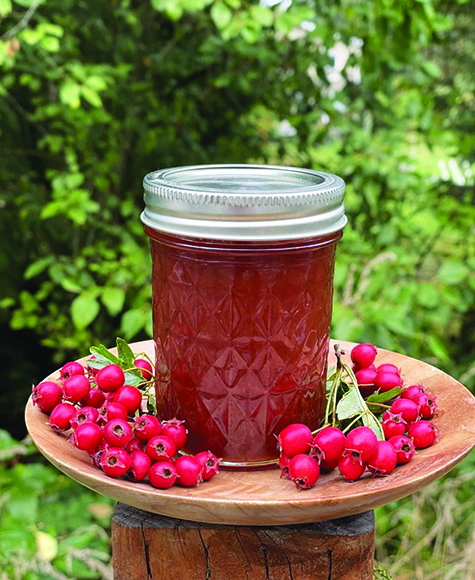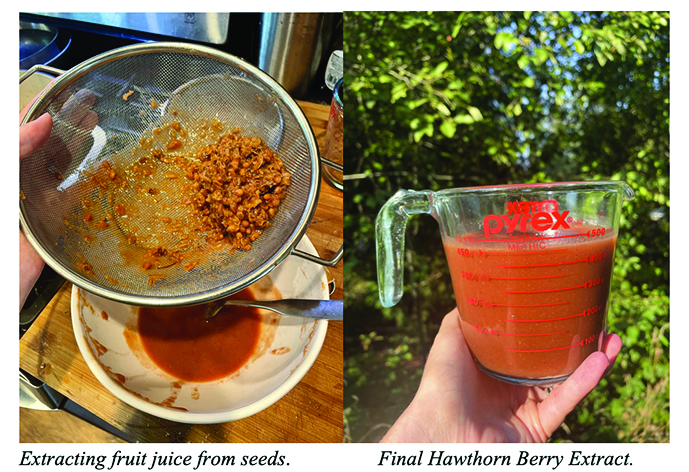
Submitted by AnneCherise Ramsey
People throughout the world value the Hawthorne plant as food and medicine for strengthening the heart and blood vessels. The Lushootseed word for the Hawthorne Plant is čibadac, and is a valued plant ally of the Coast Salish peoples. Čibadac has been used as traditional medicine in Indigenous communities for thousands of years. Hawthorne is best known as a cardiovascular tonic, easing pressure on the heart. It is a very safe plant to consume, with a wide variety of health benefits, aiding in easing instances of both physical and emotional stress. In this article, we will discuss the primary health benefits of Hawthorn, while also providing you with information needed to identify, forage, process and consume Hawthorn as a traditional Coast Salish food.
Identifying Hawthorne:
Hawthorne is a large shrub or deciduous tree with branches armored with large thorns. It is a part of the Rose family. Hawthorn trees can be small, ranging only a few feet tall, to up to 30-40 feet in size. Hawthorne is a native plant grown all around the Northern Hemisphere of the world, including America, Europe, Central Asia and even parts of Africa. There are over 280 species. The leaves are serrated, with medium to dark green colored leaves. In the Spring, Hawthornes leaves are soft and edible, with beautiful pinkish-white, fragrant floral blossoms. In the fall, the Hawthorn tree provides us with beautiful light-dark red Hawthorn Berries. The darker and brighter the berry, the richer it is in antioxidants. The flesh of the berries is edible, however the large seed inside is not.
When and How to Harvest:
Though the flowers, leaves and berries are all edible, in this article we will primarily focus on the Hawthorne Berries. Their prime foraging season starts in September and typically ends mid-November, all depending when the first frost hits. When scavenging for Hawthorn, look for trees with bright red clusters of berries. They are bright in color, ranging from a light red color to dark burgundy. These trees can be found along river beds, forests, meadows and ocean shores. In fact, there are currently a plethora of both large and small Hawthorn trees growing alongside the Tulalip Bay, with thousands of beautiful ripe Hawthorne Berries, eager to be discovered. The berries can easily be plucked, but be careful as the branches contain thorns. As you forage these beautiful berries, remember to only take what you need, giving thanks for its many blessings.

Hawthorne Food:
Hawthorn leaves and flowers can be added to salads in the springtime. In the fall, the leaves become stiffer and lose their palatability. The Hawthorn tree produces beautiful red edible berries come September. These berries taste semi-sweet, with a mild flavor, but contain a large seed that should not be consumed. Like cherry pits and apple seeds, the seeds contain cyclic acid, which should be avoided unless cooked or dried. Freshly picked, you can eat the outer flesh of the berry and spit out the seed.
Hawthorne Berries have an oily texture, and naturally contain pectin, a thickening agent used in making jams and jellies, making an excellent addition to any jelly recipe. Hawthorne Berries can be boiled in water and made into an extraction. They can also be dried and used into teas, or dried and ground into a powder. These are popular methods as Cyanic acid dissipates once the berries are cooked or dried. In the Hawthorne Honey recipe provided, we will be cooking the berries to create a Hawthorn Berry water extraction.
Hawthorne Nutrition / Medicine:
The heart is one of the most important, if not the most important organ in our body. It is continually pumping blood throughout our veins and arteries, delivering nutrients and removing waste products from trillions of cells. In traditional healing practices (Indigenous, Chinese, Ayurvedic, European), Hawthorne has been used as a plant ally to strengthen and open up the heart. It contains a wide variety of nutrients and antioxidants that make it a powerful medicinal food.
Hawthorne Berries are high in trace minerals such as selenium and chromium. Selenium is important for proper immune function, while chromium helps enhance the function of insulin – a hormone that helps regulate blood sugar levels (GoodGrub).
Hawthorn is packed with Antioxidants and Flavonoids: these are the plant compounds that help give food their color. The darker the berry, the more antioxidants and flavonoids are found. These compounds help support the overall vitality of the heart and cardiovascular system. They strengthen the blood vessels and help heal damaged vessel walls. “If it is used regularly, it can help balance both high and low blood pressure through increasing the heart’s ability to contract while gently relaxing outer blood vessels. Hawthorn also relaxes the smooth muscles of the coronary artery walls and allows more blood to flow into the cells of the heart. This means more oxygen and nutrients are delivered to heart cells and waste products are removed. It is therefore supportive for acute conditions like angina (chest pain). Hawthorn is also helpful in treating or preventing atherosclerosis (hardening of the arteries), which contributes to angina and heart attacks (GoodGrub)”.
Improved Circulation: Hawthorne is used to improve circulation, thus assisting in better brain health, mood and memory (Chevallier). Hawthorne should be consumed regularly to optimize its potential health benefits

Hawthorn čibadac Extract & Hawthorn Honey
Ingredients:
- 1 cup fresh Hawthorn Berries
- 1 cup filtered water
- 1 cup honey
- 1 Tbsp Lemon or Lime Juice
- Utensils:
- Basket
- Measuring Cup
- Saucepan
- Potato Masher
- Fine Strainer
- Fork
Step 1: Forage Hawthorn Berries off of the Hawthorn Tree. See harvesting & identification instructions above. Be sure to properly identify berries from multiple sources before consuming wild foods.
Step 2: Remove berries from stem and leaves, leaving only the berries. Rinse and dry in warm water.
Stem 3: Boil berries in filtered water. Use a 1:1 ratio. For every 1 cup of berries, boil in 1 cup of water. Bring to a boil for 5-10 minutes, then reduce to low heat. Simmer for another 45 minus – hour, until the berries are soft. Berries should turn to a dull yellow/orange color from a bright red color.
Step 4: Once berries are soft, begin the mashing process by using a potato masher. Mash the berries to separate the edible portion of the berry from the seed. This process can take anywhere from 10-20 minutes depending on the quantity of berries cooked. Note, the berry portion of the berries are edible, but the seeds are not. The objective of the mashing process is to extract the edible berry fruit from the seeds.
Step 5 – Hawthorn Extract: Take mashed Hawthorne berries and run them through a fine-tuned strainer. Use a fork to mash out the maximum amount of juice from the seeds. This process takes time. Final product of hawthorn berry should look like a ketchup-like substance, it should naturally be a thick liquid due its naturally occurring amounts of pectin. From here, the hawthorn berry extract can be made into jams, jellies, soups, and in this recipe, added to honey.
Step 6 – Hawthorne Honey: Add 1/3 cup of Hawthorn extract to 2/3 cup of honey. Continue to add 1 Tbsp of Lemon juice for extra flavor and preservation. Stir Well. Store in the refrigerator. Use as an ingredient in your favorite teas for a healthy beverage sweetener.
Sources:
- 1. https://www.goodgrub.org/post/plant-of-the-month-hawthorne
- 2. http://wildfoodsandmedicines.com/hawthorn/
- 3. https://tulaliplushootseed.com/?s=plants
- 4. Encyclopedia of Herbal Medicine, Andrew Chevallier.
This institution is an equal opportunity provider. This material was funded by USDA’s Supplemental Nutrition Assistance Program – SNAP.
Persons with disabilities who require alternative means for communication or program information or reasonable accommodation, please contact Annie Ramsey at 360-716-5632 or ajensen@tulaliptribes-nsn.gov.